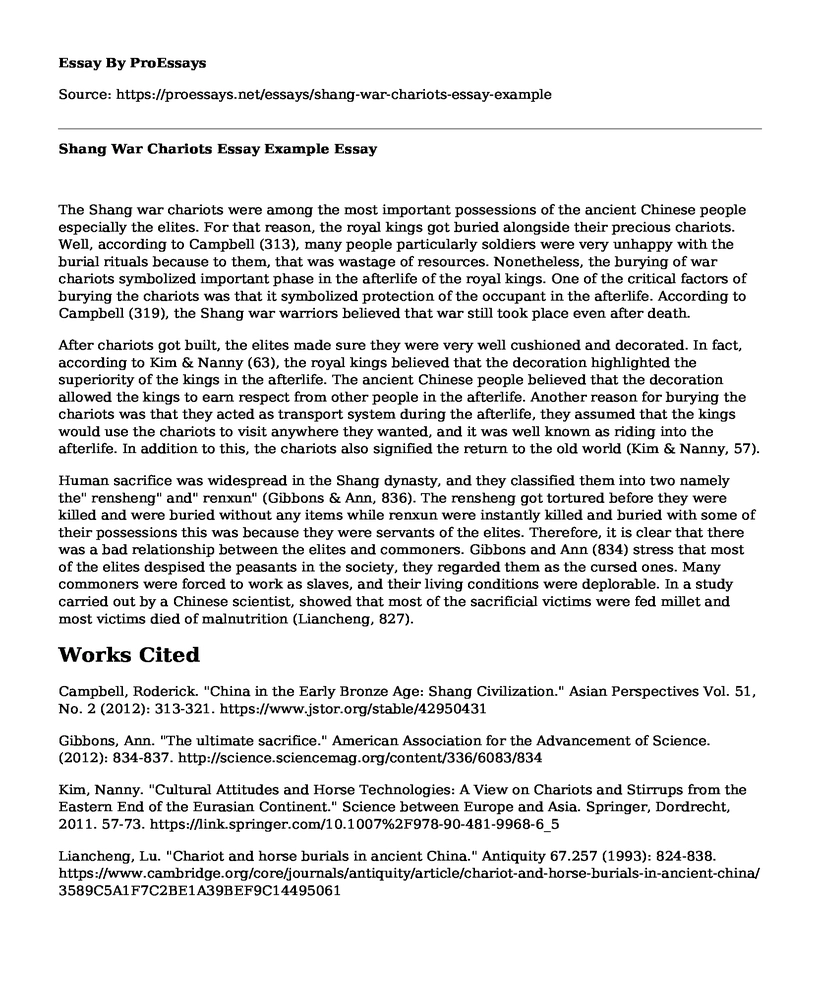The Shang war chariots were among the most important possessions of the ancient Chinese people especially the elites. For that reason, the royal kings got buried alongside their precious chariots. Well, according to Campbell (313), many people particularly soldiers were very unhappy with the burial rituals because to them, that was wastage of resources. Nonetheless, the burying of war chariots symbolized important phase in the afterlife of the royal kings. One of the critical factors of burying the chariots was that it symbolized protection of the occupant in the afterlife. According to Campbell (319), the Shang war warriors believed that war still took place even after death.
After chariots got built, the elites made sure they were very well cushioned and decorated. In fact, according to Kim & Nanny (63), the royal kings believed that the decoration highlighted the superiority of the kings in the afterlife. The ancient Chinese people believed that the decoration allowed the kings to earn respect from other people in the afterlife. Another reason for burying the chariots was that they acted as transport system during the afterlife, they assumed that the kings would use the chariots to visit anywhere they wanted, and it was well known as riding into the afterlife. In addition to this, the chariots also signified the return to the old world (Kim & Nanny, 57).
Human sacrifice was widespread in the Shang dynasty, and they classified them into two namely the" rensheng" and" renxun" (Gibbons & Ann, 836). The rensheng got tortured before they were killed and were buried without any items while renxun were instantly killed and buried with some of their possessions this was because they were servants of the elites. Therefore, it is clear that there was a bad relationship between the elites and commoners. Gibbons and Ann (834) stress that most of the elites despised the peasants in the society, they regarded them as the cursed ones. Many commoners were forced to work as slaves, and their living conditions were deplorable. In a study carried out by a Chinese scientist, showed that most of the sacrificial victims were fed millet and most victims died of malnutrition (Liancheng, 827).
Works Cited
Campbell, Roderick. "China in the Early Bronze Age: Shang Civilization." Asian Perspectives Vol. 51, No. 2 (2012): 313-321. https://www.jstor.org/stable/42950431
Gibbons, Ann. "The ultimate sacrifice." American Association for the Advancement of Science. (2012): 834-837. http://science.sciencemag.org/content/336/6083/834
Kim, Nanny. "Cultural Attitudes and Horse Technologies: A View on Chariots and Stirrups from the Eastern End of the Eurasian Continent." Science between Europe and Asia. Springer, Dordrecht, 2011. 57-73. https://link.springer.com/10.1007%2F978-90-481-9968-6_5
Liancheng, Lu. "Chariot and horse burials in ancient China." Antiquity 67.257 (1993): 824-838. https://www.cambridge.org/core/journals/antiquity/article/chariot-and-horse-burials-in-ancient-china/3589C5A1F7C2BE1A39BEF9C14495061
Cite this page
Shang War Chariots Essay Example. (2022, Nov 20). Retrieved from https://proessays.net/essays/shang-war-chariots-essay-example
If you are the original author of this essay and no longer wish to have it published on the ProEssays website, please click below to request its removal:
- Paper Example on Naturalism, Realism, Modernism in Literature
- Homogeneity of the Middle East Essay Example
- Summary of Gandhi Film - Essay Sample
- The 1919 Shock that Secure the Black Vote: A Look at the Aftermath of WWI - Essay Sample
- Essay Example on Nurses' Ethics: A Grim Reminder During Nazi Era
- Paper Sample on Immigration to the U.S.: Detention and Discrimination of Foreigners
- Profiles of Texas Government Leaders: Abbott, Patrick, and Paxton - Essay Example







